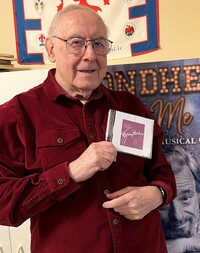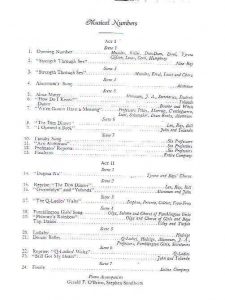News
A rare recording of a musical by an 18-year-old Stephen Sondheim surfaces
By: Bob Mondello I NPR
Posted on:
WASHINGTON, D.C. (NPR) — A rare recording of a show Broadway composer and lyricist Stephen Sondheim wrote and performed —in college — has been discovered hidden in a bookshelf in Milwaukee.
With 18 major musicals to his credit — from the vaudeville-inspired romp A Funny Thing Happened on the Way to the Forum, to the ghoulish Sweeney Todd, to the Pulitzer-winning Sunday in the Park with George — the mature Sondheim is the most respected and influential figure in American musical theater.
But he had to start somewhere.
A prodigy’s collegiate musical
Sondheim was an 18-year-old sophomore at Williams College in Massachusetts in 1948, and a founding member of its Cap and Bells drama society, when he wrote the satirical musical Phinney’s Rainbow. The title was a riff on the then-popular musical Finian’s Rainbow and the middle name of college president James Phinney Baxter III.
With four performances in April and May, the show told the story of students trying to turn a college much like Williams into Party Central and featured 25 songs with music and lyrics written by Sondheim.
It is arguably Sondheim’s first produced musical (he’d penned one in high school called By George), and it’s the stuff of legend in theater circles because nobody’s heard much of it.
Sheet music for three of the songs was published in 1948. But of recordings available to the public, there’s just the overture, performed by Sondheim and recorded at one of the Williams College performances, which has been included in anthologies. And an orchestrated but lyric-less version of the show’s song “What Do I Know?” — recorded the same year — was included on the album “Sondheim Sings, Vol. 2.”
The show literally fell through the cracks
But with no known copies of the script or lyrics, that’s been more or less it — until journalist Paul Salsini started reorganizing his cluttered office shelves. He is the founder and editor of The Sondheim Review, and author of the recently published memoir, Sondheim and Me: Revealing a Musical Genius.

A CD had slipped down, “literally fell through the cracks — and fell into the next shelf below,” Salsini recalls.
And it stayed there for who knows how long. But as soon as he played it, he realized what he’d found: an hour and 20 minutes of never-published, long missing songs from Phinney’s Rainbow.
“I knew the value of this right away — that this was the first original cast recording of a Sondheim show,” he chuckles.
This came as a surprise to Mark Eden Horowitz, a senior music specialist at the Library of Congress whose specialty is musical theater and who worked with Sondheim on several projects.
“As somebody who’s lived and breathed Sondheim to the degree I’ve been able to for my entire adult life, this is a score I really don’t know,” he says, adding that he had no idea that a performance recording existed.
How did it get recorded? Salsini theorizes that Sondheim’s mentor, lyricist Oscar Hammerstein II, put him up to it.
Putting it together, bit by bit
“I read somewhere that Hammerstein encouraged him to buy an acetate recorder and record his work and I’m sure that Sondheim himself did this recording,” he says.
Horowitz hadn’t heard that, but finds it plausible. “[Sondheim] was always an early adopter of technology and it wouldn’t surprise me. He always loved gadgets, and I know he used to make home movie type things.”
So what’s there? Salsini knows Sondheim’s later shows well, and hears in his work as an 18-year-old “hints of what is to come.” He notes that a song called “Strength Through Sex” is reminiscent of “Gee, Officer Krupke” from West Side Story, for which Sondheim would write lyrics nine years later. A rapid-fire patter song reminds him of the tongue-twisting “Not Getting Married” from Company. A waltz suggests the ones Sondheim would write in A Little Night Music.
A yearning for affection
But the song that really stood out for him was “What Do I Know?” Salsini says it was written in an hour to satisfy production demands. “They had to change scenery so they asked Sondheim to write a song that could be sung in front of the curtain.”
Reading a bit of the lyric, Salsini nearly tears up.
You said “goodbye” when I said “hello”
and I asked you when, and you said I would know
but how do I know, when I know that you said “no”
“That sounds so poignant to me,” he says. “Here’s this 18-yr-old teenager who’s discovering himself and was sent away to school and he was longing for affection.”
So many of his songs express this yearning for affection, Salsini says, and he says “What Do I Know?” is “indicative” of later songs such as Company‘s “Being Alive” and “Losing My Mind” from Follies.

The reason they’ve not been able to look at it before now, ironically, is that Sondheim hid his early work, even from Salsini’s magazine The Sondheim Review.
“I know how he felt about juvenilia because he got so upset when we published lyrics for his high school show, By George,” Salsini remembers.
But the Library of Congress’ Horowitz suggests he might have been willing to bend in this case. “My experience with Sondheim is it all depends on his mood and when you approached him about things. He was a collector himself and he appreciated collections of things, so from that perspective I think he would be at least moderately approving.”
And the fact that it’s happened now is a mitigating factor as Sondheim was often quoted as saying he didn’t care what happened after his death. “I think if he were coming back from the ether, this would not be something he would get apoplectic about,” Horowitz.
The art of making art
In fact, Horowitz says the mentor and teacher in Sondheim might even approve.
“He thought it was valuable for people to see early work and mediocre work and realize that even one’s heroes grew over time,” he says.
Salsini, who’s donating the CD to the Sondheim Research Collection in Milwaukee, admits he’s not sure where this particular discovery came from, though he’s certain it wasn’t from Sondheim. Logically, since it’s a CD — and they weren’t invented until 1982 — it’s a copy, and he notes that there are likely other copies.
Indeed, in a few hours of nosing around, Horowitz found another copy of Phinney’s Rainbow in the private collection of playwright and screenwriter Michael Mitnick. So Sondheim’s “juvenilia” in this case hasn’t so much been missing, as hiding in plain sight.
As for whether Sondheim’s collegiate efforts strike listeners today as literally sophomoric, Horowitz is sanguine. “He’s still pretty smart and talented. It may not reach the exalted levels that his later work achieves, but I’ve never seen anything among this work that I would think he would be embarrassed by.”
9(MDU1ODUxOTA3MDE2MDQwNjY2NjEyM2Q3ZA000))

